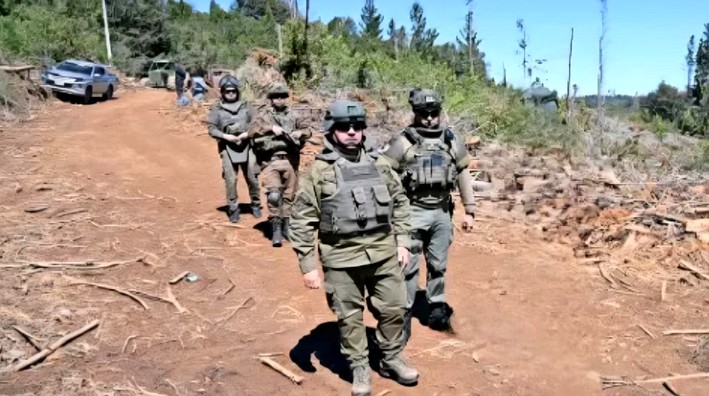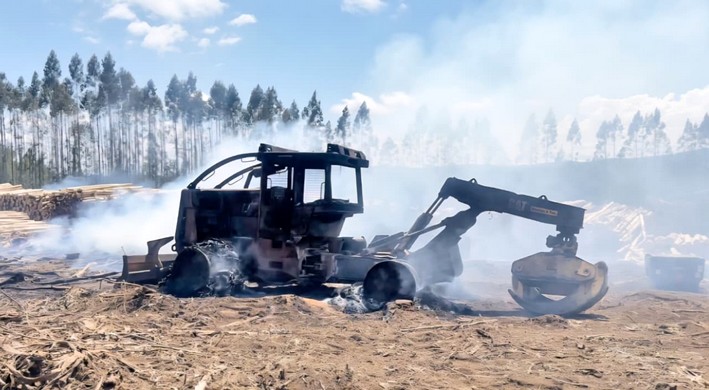Forest Fires Highlight the Need for Greater Prevention and Harsher Penalties
It is often said that lessons must be learned after tragedies, and that is what the forestry sector is advocating today, along with analyzing the consequences left by the fires in a significant portion of south-central Chile.
Mario Hermosilla, vice president of the National Forestry Society (SNF), began by emphasizing that this year's fire was the second mega-fire in history. The previous one affected 580,000 hectares, and this one has already reached nearly 450,000. "This had never happened in Chile, as they multiply by 10 what occurs in a normal year. What happened is very damaging because it literally turns a large part of the plantations into smoke. 240,000 hectares of plantations were affected, and of those, at least 150,000 belong to small and medium-sized owners," he explained. He even pointed out that 20,000 hectares equate to $100 million, meaning the actual damage to plantations exceeds $1.2 billion.
Additionally, he noted that highly clayey soils are scorched, burning the entire organic layer and causing immense environmental damage. He added that this releases a significant amount of carbon, as the soil stores 60% of the carbon captured by forests. The remaining 40% comes from the trees, but 60% is in the soil.
Identifying the Problem
Given this complex scenario, Hermosilla stated that the root problem must first be identified, stressing that the first mega-fire in 2017 was primarily caused by negligence, aided by malicious individuals who deliberately set forests ablaze. "That malicious work caused the fire to escalate beyond the firefighting capabilities of companies and CONAF that year, but fundamentally, it was due to carelessness—such as cutting electrical cables or someone failing to take precautions while trying to control bees with smoke," among many other causes, he explained.
However, amid all this, what was achieved was coordination between forestry companies and CONAF, which he deemed highly relevant. It was also agreed that whoever arrived first at a fire would attempt to contain it, which greatly helped small landowners, as this was not previously done.
Furthermore, companies, together with the state, more than doubled resources for subsequent seasons. If previously around $90 million was invested, today it is $220 million. Aerial firefighting was also optimized with aircraft capable of carrying larger water capacities.
"Those were the consequences of 2017, and now, in 2023, a second mega-fire occurred, where 80% of the damage was caused by malicious intent. Some people set fires professionally—they organized, identified where they could cause the most damage, analyzed expected temperatures and weather forecasts, and then acted with impunity, leading to the consequences we all saw," he stated.
Legislative Work
Therefore, he believes the diagnosis is crucial, as a solution must be proposed to pursue these individuals—something only the Chilean government and state can do. "Legislators must work to approve severe penalties that the judicial system can apply so these people learn their lesson and, ultimately, fear committing such crimes," he asserted. Equally important is the state creating a specialized force to document malicious actions during fire season and provide evidence to the judiciary. "We will have to get used to spending summers under states of emergency and exception, which are very necessary, as by the time the state of exception was declared, 88% of the affected area had already burned. The government must act faster."
The scale of this fire was such that, according to Hermosilla, tens of thousands of hectares will be abandoned, as happened in 2017 between the Maule and Biobío regions—a scenario that could repeat if burned forests are not properly regenerated or reforested.
Given this outlook, he projected that firewood and construction timber prices will drop, as sawmills will have a large supply.
Long Fire Season
Juan José Ugarte, president of CORMA, added that it is first important to reinforce the idea that "we still have a long fire season ahead. We estimate that in April, conditions for fire spread will remain severe. Therefore, resources must not be demobilized, states of exception must be maintained, and road patrols must continue, as these are essential to prevent further expansion of this catastrophe."
He also noted that it is now clear to everyone that in Chile, fires are not natural disasters. "Particularly this season, I can assert that in the macro-zone regions, 100% of the incidents were human-caused. Thus, though uncomfortable for some, fires are a security issue."
"Figures from specialized firefighters, both public and private, indicate 66% intentionality in the Biobío Region, with some communes exceeding 80% intentional fires. Therefore, the first step for this season and to develop an effective future strategy is to acknowledge that this is not natural—it is human-made, with a high degree of intentionality."
In this context, Ugarte stressed the need for a shared diagnosis, as Chile deserves an explanation. After 2017, he noted, a standard of 60,000 burned hectares had been achieved, but this year, that figure will be eight times higher.
Thus, he argued that a shared diagnosis should lead to a strategy focusing on:
"We believe that starting a fire during a state of exception or catastrophe, under extreme climate conditions, is as serious as drunk driving. The penalty cannot be light or a mere warning—people cannot walk free after negligent, inexcusable behavior that may have even cost lives," he emphasized.
On this matter, Juan José Ugarte praised the government for listening to these arguments, noting that penalties for intentional fires have already been significantly raised. "It is now 20 years in prison for anyone caught in the act of causing a fire—an extremely severe penalty. The problem is that the perpetrators are not being caught."
He mentioned that forestry companies have filed 731 complaints and lawsuits, providing all necessary evidence to definitively identify those responsible for these actions.

















